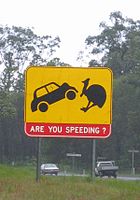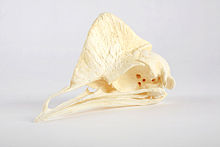Cassowary
| Cassowary | ||||||||||||
|---|---|---|---|---|---|---|---|---|---|---|---|---|

Cassowary ( Casuarius casuarius ) |
||||||||||||
| Systematics | ||||||||||||
|
||||||||||||
| Scientific name | ||||||||||||
| Casuarius casuarius | ||||||||||||
| ( Linnaeus , 1758) |
The cassowary ( Casuarius casuarius ) is a large flightless bird species from the Casuariidae family .
features
The cassowary is the second largest living bird in Australia and the third or fourth largest bird still alive today; only the African ostrich ( Struthio camelus ), the great emu ( Dromaius novaehollandiae ) and possibly the closely related single-lobed cassowary ( Casuarius unappendiculatus ) are larger. Adult cassowaries are up to 1.70 meters high and weigh up to 70 kilograms. The females are larger than the males, but otherwise indistinguishable.
Southern cassowary have a large helmet-like, coated with horn tissue structure on the head, which may serve to protect when the animals break through the undergrowth, or in battles with rivals or decorative function, has to a study published in February 2019 study but the thermoregulation is . Head and neck are not feathered; the bare skin is mostly bright blue, only a stripe on the back of the neck and several flaps of skin on the front and back of the neck are colored red. The plumage is shiny black in adult animals. Young, half-grown cassowaries have brown plumage, pale skin areas and shorter skin flaps on the neck.
Their three-toed feet have sharp claws; the dagger-like inner claw becomes up to 12 centimeters long.
They can reach a speed of 50 km / h and jump up to 1.5 m high. They are also good swimmers.
distribution and habitat
Red cassowaries occur in New Guinea and in Queensland in northeast Australia. There they lead a shy and inconspicuous life in undergrowth-rich vegetation, in rainforests and savanna forests.
Diet and Lifestyle
Cassowaries feed mainly on fruits , mushrooms , insects , small mammals, small birds and eggs . Except in the breeding season they live individually and are very territorial. If the birds are cornered, they can give out powerful kicks which, because of the long, dagger-like, inner claws, can also be life-threatening for a person.
Reproduction
Cassowaries prefer to breed in the dry season from June to October. The male builds the nest , a shallow depression in the ground that is lined with grass and leaves and well camouflaged. It only mates with a single female, which then lays three to eight large, bright green-blue eggs in the nest. The eggs measure approximately 9 cm × 14 cm. The female then moves on and can still mate with other males. The male incubates the eggs for about two months and then takes care of the brown-striped chicks for another nine months. These are refugees .
Danger

The IUCN currently classifies the cassowary as "not endangered" ( least concern ). Estimates of current populations in the wild range from 1,500 to 10,000 animals. The shrinkage of living space plays an essential role in this. In Australia, where only small areas are available to the animals anyway, there is also the threat of feral pigs who steal the eggs and chicks. The worst enemy, however, is road traffic, even in some national parks the greatest losses are due to cars and trucks moving too fast. Every year around 10 cassowaries die as so-called roadkills. Another problem is the frequent feeding of cassowaries by tourists: As soon as these people see people as a potential source of food, they develop a demanding, aggressive behavior, lose their natural shyness and often die as road kill. Occasionally, human food also causes disease. In rare cases, helmet cassowaries also pose a threat to humans, especially males, who often defend their chicks very aggressively with kicks in their claws. In New Guinea, helmet cassowaries are heavily hunted for their feathers, which are used as ceremonial headdresses.
Web links
- Videos, photos and sound recordings about Casuarius casuarius in the Internet Bird Collection
Individual evidence
- ↑ Danielle L. Eastick et al. 2019. Cassowary casques act as thermal windows. Scientific Reports 9, article number: 1966; doi: 10.1038 / s41598-019-38780-8
- ↑ Casuarius casuarius in the endangered Red List species the IUCN 2018 Posted by: BirdLife International, 2018. Accessed April 24, 2020th
- ↑ Queensland Government Information Boards




